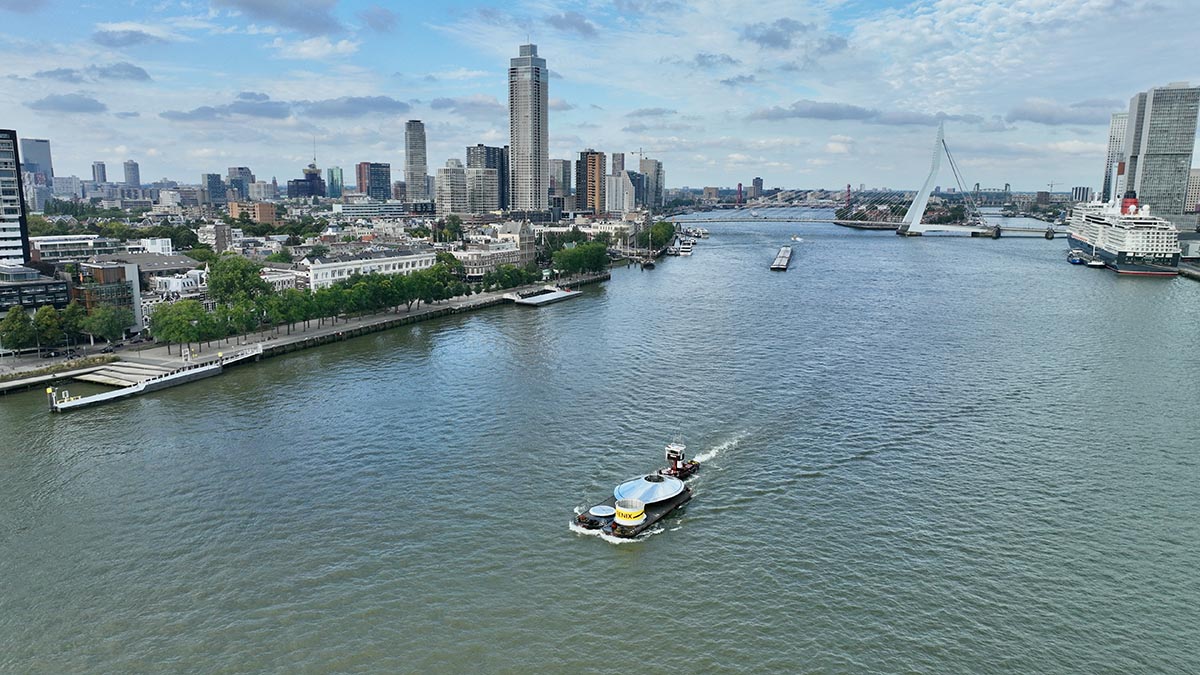Submitted by WA Contents
MAD's Fenix Museum tops out with its iconic "Tornado" structure in Rotterdam
Netherlands Architecture News - Oct 04, 2024 - 12:35 3445 views
The Fenix Museum by MAD Architects has topped out in Rotterdam with its iconic "Tornado", a dynamic structure that rises from the ground floor and flows out of the rooftop onto a platform.
The Tornado structure is suspended above the city, evoking the rising air. It serves as a metaphor for the travels that migrants take all over the world.
Named FENIX Museum of Migration, it is the first cultural project of MAD in Europe. The project was commissioned by the Droom en Daad Foundation.
Image © Frank Hanswijk
FENIX, the world's first museum devoted to migrant stories, will debut in Rotterdam's spring of 2025, showcasing a collection of artwork from over 80 international artists.
The museum is located in a 16,000 square foot (1,486 square meters) former warehouse on a prominent location in the center of Rotterdam's historic harbor. Under the direction of conservation architects Bureau Polderman and MAD Architects, the building is currently undergoing a major transformation.
Image © Frank Hanswijk
The 297 highly polished stainless-steel panels that cover the approximately 30-meter-tall Tornado were manufactured in Groningen, Netherlands.
The 17-meter-wide canopy at the top of the structure was moved by boat from Groningen to Rotterdam and is now being lifted into position.
A 550-meter double-helix wooden staircase that rises to the building's roof and offers views of the city skyline is located inside the Tornado.
"When we were asked to work on FENIX, we knew we had to create a dialogue with the existing building and its surroundings – and with a past containing so many stories of migration, memories, and uncertainty," said Ma Yansong, Founder & Principal Partner, MAD Architects.
"In designing a new structure, we had to show this dialogue between the future and the past, and so continue the story of the building."
"The Tornado is all about the future, but it’s rooted in the past. For me, it’s a metaphor for the journeys of migrants who passed through this building," Yansong added.
Image © Frank Hanswijk
Architect Cornelis Nicolaas van Goor constructed the warehouse that houses FENIX, and it was completed in 1923. Previously referred to as the San Francisco Warehouse, it was the biggest warehouse globally.
The Holland-America Line, a prosperous Dutch cargo and passenger line that operated steamship service between the Netherlands and America and was established in Rotterdam in 1873, relied heavily on the warehouse for storage and shipping needs.
During World War II, Rotterdam suffered significant destruction. The warehouse was rebuilt in 1950 as two distinct structures, Fenix I and Fenix II, after being bombed and burned.
With public entrances from both the riverside and the city, the FENIX Museum of Migration is highly accessible and well-integrated into the surrounding community. In order to provide a variety of activities and integrate art into people's everyday lives, the ground floor blends creative, cultural, and culinary spaces.

Image © Henry Verhorst
MAD created a flexible and accessible space in the center of the building by removing the roof and facade and replacing it with glass curtain walls and ceilings. The striking staircase structure, the focal point of the scheme, has an uninterrupted frame thanks to the extensive glazing.
"This is an exciting moment in the development of Europe’s newest museum. FENIX’s story is Rotterdam’s story. And its story is of the world. One of arrivals and departures, and of constant change to face the future," said Anne Kremers, Director of FENIX.
"Working with a line-up of some of the best artists in the world, when we open next Spring, we hope to share these universal experiences in the creative space of FENIX: a next generation museum for a new generation of museum goers," Kremers added.
The Droom & Daad Foundation is funding the development of FENIX. Droom & Daad was established in 2016 with the goal of redefining Rotterdam for the twenty-first century.

Image © Henry Verhorst
The organization is creating new types of cultural and artistic institutions and nurturing fresh creative talent that captures the essence, history, and diversity of the city. Bureau Polderman has provided consultation during the building's restoration.
Image © Henry Verhorst
MAD released the first images for FENIX in 2020. MAD also revealed design and construction update for Tencent's new Shenzhen Headquarters in Shenzhen, China. In addition, the firm completed an innovation center with a "biomorphic, clover-like green roof" in Beijing.
For more information about FENIX, visit WAC's previous article.
> via MAD
